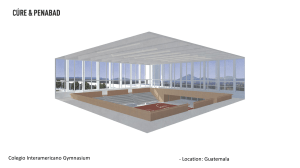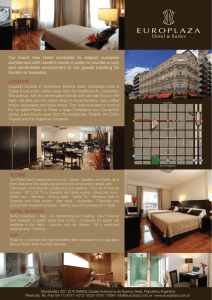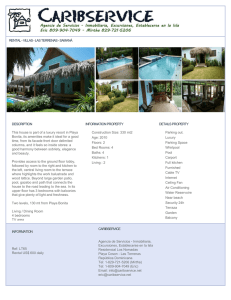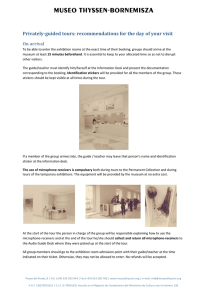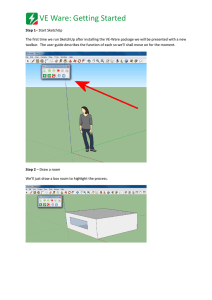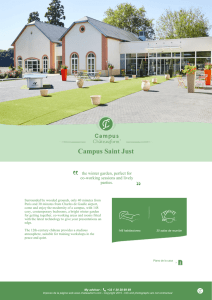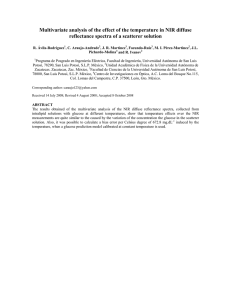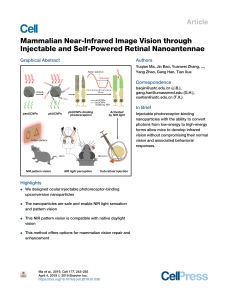ASHRAE 170-2008: Ventilation for Health Care Facilities Standard
Anuncio
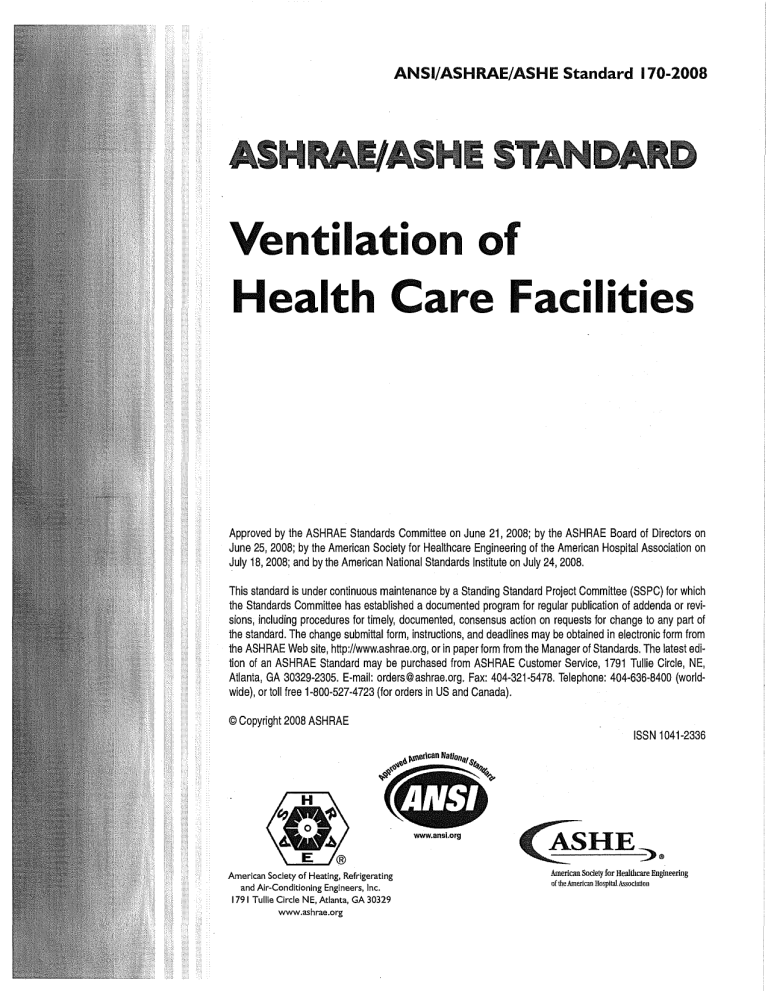
ANSI/ASHRAE/ASHE Standard 170-2008 s s ES Ventilation of Health Care Facilities Approved by the ASHRAE Standards Committee on June 21, 2008; by the ASH RAE Board of Directors on June 25, 2008; by the American Society for Healthcare Engineering of the American Hospital Association on July 18, 2008; and by the American National Standards Institute on July 24, 2008. This standard is under continuous maintenance by a Standing Standard Project Committee (SSPC) for which the Standards Committee has established a documented program for regular publication of addenda or revisions, including procedures for timely, documented, consensus action on requests for change to any part of the standard. The change submittal form, instructions, and deadlines may be obtained in electronic form from the ASH RAE Web site, http://www.ashrae.org, or in paper form from the Manager of Standards. The latest edition of an ASHRAE Standard may be purchased from ASHRAE Customer Service, 1791 Tullie Circle, NE, Atlanta, GA 30329-2305. E-mail: [email protected]. Fax: 404-321-5478. Telephone: 404-636-8400 (worldwide), or toll free 1-800-527-4723 (for orders in US and Canada). ©Copyright 2008 ASH RAE ISSN 1041-2336 www.ansl.org American Society of Heating, Refrigerating and Air-Conditioning Engineers, Inc. 1791 Tullie Circle NE, Atlanta, GA 30329 www.ashrae.org American Society for Healtltcare Engineering of the American Ho.,}lital A.~<odatlon ASHRAE Standing Standard Project Committee 170 Cognizant TC: TC 9.6, Healthcare Facilities SPLS Liaison: H. Michael Newman Richard D. Hermans, Chair* Peter Hogan Langowski* Anand K. Seth* Paul T. Ninomura, Vice-Chair* Rajendra N. Shah* Michael F. Mamayek, Secretary* Theodore Cohen* Dennis E. Shaughnessy George A. Freeman Michael Patrick Sheerin* Robert J. Weber Gerald L. Hendrickson Michael R. Keen* Michael E. Woolsey* William M. Kingrey Xudong Yang Marvin L. Kloostra* Michael Mayo Frederick H. Kohloss *Denotes members of voting status when the document was approved for publication ASHRAE STANDARDS COMMITTEE 2007-2008 Stephen D. Kennedy, Chair Nadar R. Jayaraman Hugh F. Crowther, Vice-Chair Byron W. Jones Jay A. Kohler Robert G. Baker Michael F. Beda James D. Lutz Donald L. Brandt Carol E. Marriott R. Michael Martin Steven T. Bushby Merle F. McBride Paul W. Cabot Frank Myers Kenneth W. Cooper Samuel D. Cummings, Jr. H. Michael Newman K. William Dean Lawrence J. Schoen Robert G. Doerr Bodh R. Subherwal Roger L. Hedrick Jerry W. White, Jr. Eli P. Howard, Ill Bjarne W. Olesen, BOD ExO Frank E. Jakob Lynn G. Bellanger, CO Claire B. Ramspeck, Assistant Director of Technology for Standards and Special Projects SPECIAL NOTE This American National Standard (ANS) is a national voluntary consensus standard developed under the auspices of the American Society of Heating, Refrigerating and Air-Conditioning Engineers (ASHRAE). Consensus is defined by the American National Standards Institute (ANSI), of which ASHRAE is a member and which has approved this standard as an ANS, as "substantial agreement reached by directly and materially affected interest categories. This signifies the concurrence of more than a simple majority, but not necessarily unanimity. Consensus requires that all views and objections be considered, and that an effort be made toward their resolution:' Compliance with this standard is voluntary until and unless a legal jurisdiction makes compliance mandatory through legislation. · ASH RAE obtains consensus through participation of its national and international members, associated societies, and public review. ASH RAE Standards are prepared by a Project Committee appointed specifically for the purpose of writing the Standard. The Project Committee Chair and Vice-Chair must be members of ASH RAE; while other committee members may or may not be ASHRAE members, all must be technically qualified in the subject area of the Standard. Every effort is made to balance the concerned interests on all Project Committees. The Assistant Director of Technology for Standards and Special Projects of ASH RAE should be contacted for: a. interpretation of the contents of this Standard, b. participation in the next review of the Standard, c. offering constructive criticism for improving the Standard, or d. permission to reprint portions of the Standard. DISCLAIMER ASH RAE uses its best efforts to promulgate Standards and Guidelines for the benefit of the public in light of available information and accepted industry practices. However, ASH RAE does not guarantee, certify, or assure the safety or perlormance of any products, components, or systems tested, installed, or operated in accordance with ASHRAE's Standards or Guidelines or that any tests conducted under its Standards or Guidelines will be nonhazardous or free from risk. ASHRAE INDUSTRIAL ADVERTISING POLICY ON STANDARDS ASH RAE Standards and Guidelines are established to assist industry and the public by offering a uniform method of testing for rating purposes, by suggesting safe practices in designing and installing equipment, by providing proper definitions of this equipment, and by providing other information that may serve to guide the industry. The creation of ASH RAE Standards and Guidelines is determined by the need for them, and conformance to them is completely voluntary. In referring to this Standard or Guideline and in marking of equipment and in advertising, no claim shall be made, either stated or implied, that the product has been approved by ASH RAE. CONTENTS ANSI/ASHRAEIASHE Standard 170-2008 Ventilation of Health Care Facilities PAGE SECTION Foreword ................................................................................................................................................................... 2 1 Purpose .......................................................................................................................................................... 2 2 Scope ............................................................................................................................................................. 2 3 Definitions ....................................................................................................................................................... 2 . 4 Compliance ..................................................................................................................................................... 3 5 Planning .......................................................................................................................................................... 4 6 Systems and Equipment. ................................................................................................................................ 4 7 Space Ventilation ............................................................................................................................................ 6 8 Planning, Construction, and System Start Up .............................................................................................. 11 9 Normative References .................................................................................................................................. 12 Informative Annex A ......................................................................................................................................... 12 Informative Annex B: Bibliography ................................................................................................................... 13 NOTE When addenda, interpretations, or errata to this standard have been approved, they can be downloaded free of charge from the ASH RAE Web site at www.ashrae.org. © Copyright 2008 American Society of Heating, Refrigerating and Air-Conditioning Engineers, Inc. 1791 Tullie Circle NE Atlanta, GA 30329 www.ashrae.org All rights reserved. (This foreword is not part of this standard. It is merely informative and does not contain requirements necessary for conformance to the standard. It has not been processed according to the ANSI requirements for a standard and may contain material that has not been subject to public review or a consensus process. Unresolved objectors on informative material are not offered the right to appeal at ASHRAE or ANSI.) 2.2 This standard applies to new buildings, additions to existing buildings, and those alterations to existing buildings that are identified within this standard. 2.3 This standard considers chemical, physical, and biological contaminants that can affect the delivery of medical care to patients; the convalescence of patients; and the safety of patients, health care workers, and visitors. 3. FOREWORD ANSVASHRAEIASHE Standard 170, Ventilation of Health Care Facilities, is one of a family of documents that offers guidance, regulation, and mandates to designers of health care facilities. It is first and foremost a mandatory minimum requirement and, as such, may not offer the state-of-theart best practice ofhealth care ventilation design. Other publications, such as the ASHRAE HVAC Design Manual for Hospitals and Clinics, may provide more depth and detail for the designer. In addition, the health care designer must refer to any design requirements from the appropriate jurisdiction that has authority. Many jurisdictions use or refer to Guidelines for Design and Construction of Hospitals and Health Care Facilities, published by the American Institute of Architects (AlA). Where practical, the committee was cognizant of these other documents in the development ofthis standard. Ventilation design for health care spaces is a combination of tasks that leads to a set of documents used in construction. One such task requires medical planners to develop departmental programs of spaces. These programs include space names that suggest the use for which the space is intended, and health care ventilation designers depend upon these names to determine the ventilation parameters for their designs. This standard provides these ventilation parameters. Without high-quality ventilation in health care facilities, patients, health care workers, and visitors can become infected through normal respiration of particles in the air. Poorly ventilated health care facilities are places where the likelihood ofpathogenic particles occurring in the air is quite high. These air-transmitted pathogens can be found everywhere in poorly ventilated health care facilities, and although most individuals can cope using their healthy immune systems, some patients are susceptible to these pathogens or even to normal environmental air-borne organisms such as fungal spores. Because these organisms are found in higher concentrations in hospitals, additional care must be taken in design ofthe ventilation systems. 1. PURPOSE The purpose of this standard is to define ventilation system design requirements that provide environmental control for comfort, asepsis, and odor in health care facilities. 2. SCOPE 2.1 The requirements in this standard apply to patient care areas and related support areas within health care facilities, including hospitals, nursing facilities, and outpatient facilities. 2 DEFINITIONS addition: an extension or increase in floor area or height of a building, building system, or equipment. airborne infection isolation (Ail): the isolation of patients infected with organisms spread by airborne droplet nuclei less than 5 ).till in diameter (see CDC [2003] in Informative Annex B: Bibliography). For the purposes ofthis standard, the abbreviation ''All" refers to the room that provides isolation. airborne infection isolation room: a room that is designed according to the requirements of this standard and that is intended to provide airborne infection isolation. alteration: a significant change in the function or size of a space, in the use of its systems, or in the use of its equipment, either through rearrangement, replacement, or addition. Routine maintenance and service shall not constitute an alteration. authority havingjurisdiction: the agent or agency responsible for enforcing this standard. average velocity: the volumetric flow rate obtained by dividing the air quantity issuing from an air distribution device by the nominal face area ofthe device. building: a structure that is wholly or partially enclosed within exterior walls and a roof, or within exterior and party walls and a roof, and that affords shelter to persons, animals, or property. In this standard, a building is a structure intended for use as a hospital or health care facility. classification of surgeries: Class A surgery: provides minor surgical procedures performed under topical, local, or regional anesthesia without preoperative sedation. Excluded are intravenous, spinal, and epidural procedures, which are Class B or C surgeries. Class B surgery: provides minor or major surgical procedures performed in conjunction with oral, parenteral, or intravenous sedation or performed with the patient under analgesic or dissociative drugs. Class C surgery: provides major surgical procedures that require general or regional block anesthesia and/or support of vital bodily functions. For more information on this method of classifYing surgeries, see ACS (2000) in Informative Annex B: Bibliography. equipment: devices for heating, ventilating, and/or air conditioning, including but not limited to furnaces, boilers, air conditioners, heat pumps, chillers, and heat exchangers. ANSI/ASHRAE/ASHE Standard 170-2008 high risk immunocompromised patients: patients who have the greatest risk of infection caused by airborne or waterborne microorganisms. These patients include but are not limited to allogeneic stem-cell transplant patients and intensive chemotherapy patients. infection control risk assessment (ICRA): a determination of the potential risk of transmission of various infectious agents in the facility, a classification of those risks, and a list of required practices for mitigating those risks during construction or renovation. immunocompromised patients: patients whose immune mechanisms are deficient because of immunologic disorders (e.g., human immunodeficiency virus [HIV] infection or congenital immune deficiency syndrome), chronic diseases (e.g., diabetes, cancer, emphysema, or cardiac failure), or immunosuppressive therapy (e.g., radiation, cytotoxic chemotherapy, anti-rejection medication, or steroids) (see CDC [2003] in Informative Annex B: Bibliography). inpatient: a patient whose stay at the health care facility is anticipated to require twenty-four hours or more of patient care. invasive imaging procedure room: a room in which radiographic imaging is used and in which instruments or devices are inserted into patients through the skin or body orifice under sterile conditions for diagnosis and/or treatment. non-aspirating diffuser: a diffuser that has unidirectional downward airflow from the ceiling with minimum entrainment of room air. Classified as ASHRAE Group E, these diffusers generally have very low average velocity. For the purposes of this standard, the performance of these diffusers is to be measured in terms of average velocity. protective environment room: a patient room that is designed according to this standard and intended to protect a high risk immunocompromised patient from human and environmental airborne pathogens. triage: the process of determining the severity of the illness of or injury to patients so that those who have the most emergent illnesses/injuries can be treated immediately and those less severely injured can be treated later or in another area. 4. 4.1 COMPLIANCE Compliance Requirements 4.1.1 New Buildings. New buildings shall comply with the provisions of this standard. 4.1.2 Existing Buildings 4.1.2.1 Additions to Existing Buildings. Additions shall comply with the provisions of this standard. 4.1.2.2 Alterations to Existing Buildings. Portions of a heating, ventilating, and air-conditioning system and other systems and equipment that are being altered shall comply with the applicable requirements of this standard. 4.1.2.2.1 Heating, Ventilation, and Air-Conditioning System Alterations. Alterations to mechanical systems serving the building heating, cooling, or ventilating needs shall comply ANSI/ASHRAE/ASHE Standard 170-2008 with the requirements of Section 6, "Systems and Equipment," applicable to those specific portions of the building and its systems that are being altered. Any new mechanical equipment installed in conjunction with the alteration as a direct replacement of existing mechanical equipment shall comply with the provisions of Sections 6.2, 6.4, 6.5, and 6.6. 4.1.2.2.2 Space Alterations. Alterations to spaces listed in Table 6-1 (see page 5) shall comply with the requirements of Section 6.7 and Section 7, "Space Ventilation," applicable to those specific portions of the building and its systems that are being altered. Any alteration to existing health care space in a building that will continue to treat patients during construction shall comply with Sections 8.1, 8.3, 8.4, and 8.5. 4.2 Administrative Requirements. Administrative requirements relating to permit requirements, enforcement by the authority having jurisdiction, interpretations, claims of exemption, approved calculation methods, rights of approved calculation methods, and rights of appeal are specified by the authority having jurisdiction. 4.3 Compliance Documents 4.3.1 General. Compliance documents are those plans, specifications, engineering calculations, diagrams, reports, and other data that are approved as part of the permit by the authority having jurisdiction. The compliance documents shall include all specific construction-related requirements of the owner's infection control risk assessment. 4.3.2 Construction Details. Compliance documents shall contain all pertinent data and features of the building, equipment, and systems in sufficient detail to allow a determination of compliance by the authority having jurisdiction and to indicate compliance with the requirements of this standard. 4.3.3 Supplemental Information. Supplemental information necessary to verify compliance with this standard, such as calculations, worksheets, compliance forms, vendor literature, or other data, shall be made available when required by the authority having jurisdiction. 4.4 Alternate Materials, Methods of Construction, or Design. The provisions of this standard are not intended to prevent the use of any material, method of construction, design, or building system not specifically prescribed herein, provided such construction, design, or building system has been approved by the authority having jurisdiction as meeting the intent of this standard. 4.5 Informative Appendices. The informative appendices to this standard and informative notes located within this standard contain recommendations, explanations, and other nonmandatory information and are not part of this standard. 4.6 Criteria Ranges. This standard often specifies a range of values that will comply with a specific requirement of the standard. If it is permitted by the authority having jurisdiction, compliance with this requirement may be achieved by the presentation of compliance documents that demonstrate a system's ability to perform within the specified range. 3 5. PLANNING Owners/managers of health care facilities shall prepare a detailed program that shall include the clinical service expected in each space, the specific equipment expected to be used in each space, and any special clinical needs for temperature, humidity, and pressure control. This program shall be prepared in the planning phase of design. nance. All airstream surfaces of air-handling units-e.g., interior surfaces and components-shall comply with Section 5.5 of ANSIIASHRAE Standard 62.1-2007, Ventilation for Acceptable Indoor Air Quality. (For more information, see ANSI/ASHRAE Standard 62.1-2007 and ASHRAE position document Minimizing Indoor Mold Problems through Management ofMoisture in Building Systems.) 6.3 6. SYSTEMS AND EQUIPMENT Air-handling and distribution systems are required to provide health care facilities not only with a comfortable environment but also with ventilation to dilute and remove contaminants, to provide conditioned air, and to assist in controlling the transmission of airborne infection. In order to meet these requirements, air-handling and distribution systems shall be designed according to the requirements of this standard. 6.1 Utilities 6.1.1 Ventilation Upon Loss of Electrical Power. The space ventilation and pressure relationship requirements of Table 7-1 (see page 7) shall be maintained for the following spaces, even in the event ofloss of normal electrical power: a. b. c. Allrooms PErooms Class B & C Operating Rooms, including Delivery Rooms (Caesarean) For further information, see NFPA 99 (2005), in Informative Annex B: Bibliography. 6.3.1 Outdoor Air Intakes. Outdoor air intakes for airhandling units shall be located a minimum of25 ft (8 m) from cooling towers and all exhaust and vent discharges. Outdoor air intakes shall be located such that the bottom of the air intake is at least six ft (2 m) above grade. Intakes on top of buildings shall be located a minimum of three ft (1m) above rooflevel. New facilities with moderate-to-high risk of natural or man-made extraordinary incidents shall locate air intakes away from public access. All intakes shall be designed to prevent the entrainment ofwind-drivenrain, shall contain features for draining away precipitation, and shall be equipped with a birdscreen of mesh no smaller than 0.5 in. (13 mm). 6.3.2 Exhaust Discharges. Exhaust discharge outlets that discharge air from All rooms, bronchoscopy rooms, emergency department waiting rooms, nuclear medicine laboratories, radiology waiting, and laboratory chemical fume hoods shall a. b. 6.1.2 Reserve Heating and Cooling Sources 6.1.2.1 Provide heat sources and essential accessories in number and arrangement sufficient to accommodate the facility needs, even when any one of the heat sources is not operating due to a breakdown or routine maintenance. The capacity of the remaining source(s) shall be sufficient to provide for sterilization and dietary purposes and to provide heating for operating, delivery, birthing, labor, recovery, emergency, intensive care, nursery, and inpatient rooms. (For further information, see AlA (2001) in Informative Annex B: Bibliography. Exception: Reserve capacity is not required if the ASHRAE 99% heating dry bulb temperature for the facility is greater than or equal to 25°F. 6.1.2.2 For central cooling systems greater than 400 tons peak cooling load, the number and arrangement of cooling sources and essential accessories shall be sufficient to support the owner's facility operation plan upon a breakdown or routine maintenance of any one of the cooling sources. Exception: Reserve capacity is not required if the ASHRAE 1% cooling dry bulb temperature is less than or equal to 85°F. 6.2 Air-Handling Unit Design 6.2.1 Air-Handling Unit Casing. The casing of the airhandling unit shall be designed to prevent water intrusion, resist corrosion, and permit access for inspection and mainte- 4 Outdoor Air Intakes and Exhaust Discharges c. be designed so that all ductwork in occupied spaces is under negative pressure; discharge in a vertical direction at least 10ft (3m) above roof level and shall be located not less than 10 ft horizontally from air intakes, openable windows/doors, or areas that are normally accessible to the public or maintenance personnel and that are higher in elevation than the exhaust discharge; and be located such that they minimize the recirculation of exhausted air back into the building. 6.4 Filtration. Filter banks shall be provided in accordance with Table 6-1. Each filter bank with an efficiency of greater than MERV 12 shall be provided with an installed manometer or differential pressure measuring device that is readily accessible and provides a reading of differential static pressure across the filter to indicate when the filter needs to be changed. (For further information, see AlA [2006] and CDC [2003] in Informative Annex B: Bibliography.) 6.4.1 First Filtration Bank. Filter Bank No. 1 shall be placed upstream of the heating and cooling coils such that all mixed air is filtered. 6.4.2 Second Filtration Bank. Filter Bank No. 2 shall be installed downstream of all wet air cooling coils and the supply fan. All second filter banks shall have sealing interface surfaces. 6.5 Heating and Cooling Systems 6.5.1 Cooling Coils and Drain Pans. Cooling coils and drain pans shall comply with the requirements of ANSI/ ASHRAE Standard 62.1-2007. ANSI/ASHRAE/ASHE Standard 170-2008 TABLE 6-1 Minimum Filter Efficiencies Space Designation (According to Function) Filter Bank Number 1 (MERV)a Filter Bank Number 2 (MERV)a Classes B and C surgery; inpatient and ambulatory diagnostic and therapeutic radiology; inpatient delivery and recovery spaces 7 14 Inpatient care, treatment, and diagnosis, and those spaces providing direct service or clean supplies and clean processing (except as noted below); AII (rooms) 7 14 Protective environment rooms (PE) 7 17 (HEPA)c Laboratories; Class A surgery and associated semi-restricted spaces 13b N/R* Administrative; bulk storage; soiled holding spaces; food preparation spaces; and laundries 7 N!R All other outpatient spaces 7 N/R Skilled nursing facilities 7 N/R * NR = not required Note a: The minimum efficiency reporting value (MERV) is based on the method of testing described inANSIIASHRAE Standard 52.2-2007, Method of Testing General Ventilation Air-Cleaning Devices for Removal Efficiency by Particle Size (see Informative Annex B: Bibliography). Note b: Additional prefilters may be used to reduce maintenance for filters with efficiencies higher than MERV 7. Note c: Filter Bank No.2 maybe a MERV 14 ifaMERV 17 tertiary terminal filter is provided for these spaces. TABLE6-2 Supply Air Outlets Space Designation (According to Function) Supply Air Outlet Classificationa All class A, B, and C surgeriesb Primary supply diffusers Group E, non-aspirating additional supply diffusers, Group E Protective environment (PE) rooms Group E, non-aspirating Wound intensive care units (bum units) Group E, non-aspirating Trauma rooms (crisis or shock) Group E, non-aspirating Ail rooms Group A or Group E All other spaces Group A or Group E Note a: Refer to 2005 ASHRAE Handbook-Fundamentals, Chapter 35, for definitions related to outlet classification and performance (see Informative Annex B: Bibliography). Note b: Surgeons may require alternate air-distribution systems for some specialized surgeries. Such systems shall be considered acceptable if they meet or exceed the requirements of this standard. 6.5.2 Radiant Cooling Systems. If radiant cooling panels are utilized, the chilled-water temperature shall always remain above the dew point temperature of the space. 6.5.3 Radiant Heating Systems. If radiant heating is provided for an All room, a protective environment room, a wound intensive care unit (bum unit), or a room for any class of surgery, either flat and smooth radiant ceiling panels with exposed cleanable surfaces or radiant floor heating shall be used. 6.6 Humidifiers. When outdoor humidity and internal moisture sources are not sufficient to meet the requirements of Table 7-1, humidification shall be provided by means of the health-care facility air-handling systems. Locate humidifiers within air-handling units or ductwork to avoid moisture accumulation in downstream components, including filters and insulation. Chemical additives used for steam humidifiers serving health care facilities shall comply with FDA requirements. 1 Reservoir-type water humidifiers or evaporative-pan-type humidifiers shall not be used in ductwork or air-handling units in health care facilities. A humidity sensor shall be provided, located at a suitable distance downstream from the steam injection source. Controls shall be provided to limit duct humidity to a maximum value of ANSI/ASHRAE/ASHE Standard 170-2008 90% RH when the humidifier is operating. Humidifier steam control valves shall be designed so that they remain OFF whenever the air-handling unit is not in operation. 6. 7 Air Distribution Systems 6.7.1 General. Maintain the pressure relationships required in Table 7-1 in all modes ofHVAC system operation, except as noted in the table. Spaces listed in Table 7-1 that have required pressure relationships shall be served by fully ducted returns. The air-distribution design shall maintain the required space pressure relationships, taking into account recommended maximum filter loading, heating-season lowered airflow operation, and cooling-season higher airflow operation. Airstream surfaces of the air-distribution system downstream of Filter Bank No.2, shall comply with Section 5.5 of ANSI/ASHRAE Standard 62.1-2007. The air-distribution system shall be provided with access doors, panels, or other means to allow convenient access for inspection and cleaning. (For further information, see ANSI/ASHRAE Standard 62.1.) 6.7.2 Air-Distribution Devices. All air-distribution devices shall meet the following requirements: 5 a. b. c. 7. Surfaces of air-distribution devices shall be suitable for cleaning. Supply air outlets in accordance with Table 6-2 shall be used: The supply diffusers in Classes B and C surgeries shall be designed and installed to allow for internal cleaning. Psychiatric, seclusion, and holding-patient rooms shall be designed with security diffusers, grilles, and registers. SPACE VENTILATION The ventilation requirements of this standard are minimums that provide control of environmental comfort, asepsis, and odor in health care facilities. However, because they are minimum requirements and because of the diversity of the population and variations in susceptibility and sensitivity, these requirements do not provide assured protection from discomfort, airborne transmission of contagions, and odors. 7.1 General Requirements. The following requirements shall apply for space ventilation: 1. 2. 3. 4, a. general b. c. Design of the ventilation system shall provide air movement that is generally from clean to less clean areas. If any form of variable-air-volume or load-shedding system is used for energy conservation, it shall not compromise the pressure balancing relationships or the minimum air changes required by the table. See Table 7-1 note (t) for additional information. The ventilation rates in this table are intended to provide for comfort as well as for asepsis and odor control in areas of a health care facility that directly affect patient care. The air change rates specified are for supply in positive pressure rooms and for exhaust in negative pressure rooms. Ventilation rates for many areas not specified here can be found in ANSI/ASHRAE Standard 62.1 (see Informative Annex B: Bibliography). Where areas with prescribed rates in both Standard 62.1-2007 and Table 7-1 of this standard exist, the higher of the two air change rates shall be used. For design purposes, the minimum number of total air changes indicated shall be either supplied for positive pressure rooms or exhausted for negative pressure rooms. For spaces that require a positive or negative pressure relationship, the number of air changes can be reduced when the space is unoccupied, provided that the required pressure relationship to adjoining spaces is maintained while the space is unoccupied and that the minimum number of air changes indicated is reestablished anytime the space becomes occupied. Air change rates in excess of the minimum values are expected in some cases in order to maintain room tempera- Air filtration for spaces shall comply with Table 6-1. Supply air outlets for spaces shall comply with Table 6-2. In All rooms, protective environment rooms, wound intensive care units (burn units), and rooms for all classes of surgery, heating with supply air or radiant panels that meet the requirements of Section 6.5 .3 shall be provided. 7.2 Additional Room Specific Requirements 7.2.1 Airborne Infection Isolation (All) Rooms. Ventilation for All rooms shall meet the following requirements whenever an infectious patient occupies the room: Spaces shall be ventilated according to Table 7-1. a. 6 ture and humidity conditions based upon the space cooling or heating load. b. c. d. e. £ Each All room shall comply with requirements of Tables 6-1, 6-2, and 7-1. All rooms shall have a permanently installed device and/or mechanism to constantly monitor the differential air pressure between the room and adjacent spaces of the room when occupied by patients with an airborne infectious disease. A local visual means shall be provided to indicate whenever negative differential pressure is not maintained. All air from the All room shall be exhausted directly to the outdoors. Exception: All rooms that are retrofitted .from standard patient rooms from which it is impractical to exhaust directly outdoors may be ventilated with recirculated air from the room's exhaust, provided that the air first passes through a HEPA (MERV 17) filter. All exhaust air from the All rooms, associated anterooms, and associated toilet rooms shall be discharged directly to · the outdoors without mixing with exhaust air from any other non-All room or exhaust system. Exhaust air grilles or registers in the patient room shall be located directly above the patient bed on the ceiling or on the wall near the head of the bed unless it can be demonstrated that such a location is not practical. The room envelope shall be sealed to limit leakage air flow at 0.01 in. we (2.5 Pa) differential pressure across the envelope. Differential pressure between All rooms and adjacent spaces that have a different function shall be a minimum of--0.01 in. we (-2.5 Pa). 7.2.2 Protective Environment (PE) Rooms. Ventilation for PE rooms shall meet the following requirements: a. b. The room envelope shall be sealed to limit leakage air flow at 0.01 in. we (2.5 Pa) differential pressure across the envelope. Each PE room shall comply with the requirements of Tables 6-1, 6-2, and 7-1. PE rooms shall have a permanently installed device and/or mechanism to constantly monitor the differential air pressure between the room and adjacent spaces of the room when occupied by patients requiring a protective environment. A local visual means shall be provided to indicate whenever positive differential pressure is not maintained. ANSI/ASHRAE/ASHE Standard 170-2008 ~ <Zl ~ TABLE 7-1 Design Parameters Pressure Relationship to Adjacent Areas (n) Minimum Outdoor ach Minimum Total ach All Room Air Exhausted Directly to Outdoors (j) Air Recirculated by Means of Room Units (a) RH(k), % Design Temperature (I), OFJOC Classes Band C operating rooms, (m), (n), (o) Positive 4 20 N/R No 30-60 68-75/20-24 Operating/surgical cystoscopic rooms, (m), (n) (o) Positive 4 20 NIR No 30-60 68-75/20-24 Delivery room (Caesarean) (m), (n), (o) Positive 4 20 N/R No 30-60 68-75/20-24 Substerile service area 2 6 NIR NIR 2 6 No 30-60 70-75/21-24 Critical and intensive care Positive 2 6 No 30-60 70-75/21-24 Wound intensive care (burn unit) Positive 2 6 NIR NIR NIR NIR No Recovery room NIR NIR No 40-60 70-75/21-24 Newborn intensive care Positive 2 6 N/R No 30-60 70-75/21-24 <Zl ~ :;;: gJ <Zl Function of Space ~ ~ p. !'; SURGERY AND CRITICAL CARE p. ::::; 0 ,:., 0 0 00 Treatment room (p) NIR 2 6 NIR N/R 30-60 70-75/21-24 Trauma room (crisis or shock) (c) Positive 3 15 N/R No 30-60 70-75/21-24 Medical/anesthesia gas storage (r) Negative NIR 8 Yes N/R NIR N/R Laser eye room Positive 3 15 NIR No 30-60 70-75/21-24 ER waiting rooms (q) Negative 2 12 Yes N/R max65 70-75/21-24 Triage Negative 2 12 Yes NIR max60 70-75/21-24 ER decontamination Negative 2 12 Yes No NIR NIR Radiology waiting rooms (q) Negative 2 12 Yes N/R max60 70-75/21-24 Class A Operating/Procedure room (o), (d) Positive 3 15 NIR No 30-60 70-75/21-24 INPATIENT NURSING Patient room (s) NIR 2 6 NIR N/R max60 70-75/21-24 Toilet room Negative NIR 10 Yes No NIR NIR NIR NIR No 30-60 72-78/22-26 No max60 70-75/21-24 70-75/21-24 N ewbom nursery suite NIR 2 6 Protective environment room (f), (n), (t) Positive 2 12 All room (e), (n), (u) Negative 2 12 Yes No max60 Ali isolation anteroom (t) (u) NIR NIR NIR NIR 10 Yes No NIR NIR 2 6 NIR max60 70-75/21-24 2 6 NIR NIR N/R max60 70-75/21-24 Labor/delivery/recovery/postpartum (LDRP) (s) Labor/delivery/recovery (LDR) (s) Note: NIR =no requirement TABLE 7-1 Design Parameters Function of Space Pressure Relationship to Adjacent Areas (n) Minimum Outdoor ach Minimum Total ach All Room Air Exhausted Directly to Outdoors (j) Air Recirculated by Means of Room Units (a) RH(k), % Design Temperature (1), °F/°C Corridor N/R NIR 2 N!R NIR N!R N!R N!R NIR 2 2 4 4 Physical therapy Negative 2 6 NIR NIR NIR NIR N!R 70-75/21-24 Resident gathering/activity/dining 00 SKILLED NURSING FACILITY Occupational therapy N!R 2 6 NIR N!R NIR NIR Bathing room Negative N!R 10 Yes NIR NIR NIR NIR NIR NIR 2 6 N/R NIR max60 72-78/22-26 Resident room 70--75/21-24 70--75/21-24 70--75/21-24 70-75/21-24 RADIOLOGY (v) X-ray (diagnostic and treatment) X-ray (surgery/critical care and catheterization) Positive 3 15 N!R No max60 70--75/21-24 Darkroom (g) Negative 2 10 Yes No N!R N!R Bronchoscopy, sputum collection, and pentamidine administration (n) Negative 2 12 Yes No N!R 68-73/20--23 Laboratory, general (v) Negative 2 6 N!R No N!R N!R N!R N!R N!R NIR N!R NIR N!R N!R NIR N!R N!R N!R NIR 70--75/21-24 DIAGNOSTIC AND TREATMENT Laboratory, bacteriology (v) Negative 2 6 Yes No Laboratory, biochemistry (v) Negative 2 6 Yes No Laboratory, cytology (v) Negative 2 6 Yes No Laboratory, glasswashing Negative 2 10 Yes No Laboratory, histology (v) Negative 2 6 Yes No Laboratory, microbiology (v) Negative 2 6 Yes No Laboratory, nuclear medicine (v) Negative 2 6 Yes No Laboratory, pathology (v) Negative 2 6 Yes No Laboratory, serology (v) Negative 2 6 Yes No Laboratory, sterilizing Negative 2 10 Yes No ffi Laboratory, media transfer (v) Positive 2 4 N!R No or Autopsy room (n) Negative 2 12 Yes No -a_, Nomefrigerated body-holding room (h) Negative NIR 10 Yes No Pharmacy (b) Positive 2 4 NIR N!R ~ rn §2 rn ~ :;;: rn rn ::; 0.. 0 1-J 0 0 00 Note: N!R ~no requirement 70--75/21-24 70--75/21-24 70--75/21-24 N!R 70-75/21-24 70-75/21-24 . 70--75/21-24 70-75/21-24 70--75/21-24 70-75/21-24 70-75/21-24 68-75/20-24 70-75/21-24 NIR TABLE7-1 Design Parameters Pressure Relationship to Adjacent Areas (n) Minimum Outdoorach Minimum Total ach All Room Air Exhausted Directly to Outdoors (j) Examination room N/R 2 6 Medication room Positive 2 4 ~ >r:n r:n ~ ~ Function of Space ::;;: r:n gJ r:n g 0. ""0.'"' ...... ._, Air Recirculated by Means of Room Units (a) RH(k), % Design Temperature (I), N/R N/R max60 70-75/21-24 N!R N/R max60 70--75/21-24 30-60 68-73/20-23 OFJOC Endoscopy Positive 2 15 N/R No 0 Endoscope cleaning Negative 2 10 Yes No N/R N/R 0 Treatment room N/R 2 6 N/R N/R max60 70--75/21-24 Hydrotherapy Negative 2 6 N/R N/R N/R 72-80/22-27 Physical therapy Negative 2 6 N/R N/R Max65 72-80/22-27 Negative N/R 10 Yes No N!R N/R Negative 2 6 Yes No N/R 72-78/22-26 '-'0 00 STERILIZING Sterilizer equipment room CENTRAL MEDICAL AND SURGICAL SUPPLY Soiled or decontamination room Clean workroom Positive 2 4 N/R No max60 72-78/22-26 Sterile storage Positive 2 4 N/R N!R max60 72-78/22-26 SERVICE Food preparation center (i) N/R 2 10 NIR No N/R 72-78/22-26 Warewashing Negative N!R 10 Yes No N!R N!R Dietary storage N/R N/R 2 N/R No N/R 72-78/22-26 Laundry, general Negative 2 10 Yes No N/R Soiled linen sorting and storage Negative 10 Yes No N!R N!R N!R 2 N/R N/R N/R 72-78/22-26 10 Yes No N/R Clean linen storage Positive Linen and trash chute room Negative N!R N!R N!R Bedpan room Negative N/R 10 Yes No N!R N!R Bathroom Negative Yes No N/R 72-78/22-26 Negative NIR N!R 10 Janitor's closet 10 Yes No N/R N/R Soiled workroom or soiled holding Negative 2 10 Yes No N/R N/R Clean workroom or clean holding Positive 2 4 N/R N/R N/R N/R Hazardous material storage Negative 2 10 Yes No N!R N/R N!R SUPPORT SPACE Note: NIR =no requirement :; Table 7-1 Notes: a. b. c. d. e. f. g. h. i. j. k. 1. m. n. o. p. q. r. s. t. u. "' I ..... ...., 0 w 0 0 00 v. Recirculating room HVAC units (with heating or cooling coils) are acceptable to achieve the required air change rates. Because of the cleaning difficulty and the potential for buildup of contamination, recirculating room units shall not be used in areas marked ''No." Isolation and intensive care unit rooms may be ventilated by reheat induction units in which only the primary air supplied from a central system passes through the reheat unit. Gravity-type heating or cooling units, such as radiators or convectors, shall not be used in operating rooms and other special care areas. Pharmacy compounding areas may have additional air change and filtering requirements beyond the minimum of this table depending on the type of pharmacy, the regulatory requirements (which may include adoption ofUSP 797), the associated level of risk of the work (see USP 797), and the equipment utilized in the spaces. The term trauma room as used herein is a first aid room and/or emergency room used for general initial treatment of accident victims. The operating room within the trauma center that is routinely used for emergency surgery is considered to be an operating room by this Standard. Pressure relationships need not be maintained when the room is unoccupied. Some isolation rooms may be provided with a separate anteroom, but an ante room is not required by this standard. Protective environment rooms are those used for high-risk irnmunocompromised patients. Such rooms are positively pressurized relative to all adjoining spaces to protect the patient. Exception: All air need not be exhausted if darkroom equipment has a scavenging exhaust duct attached and meets ventilation standards regarding NIOSH, OSHA, and local employee exposure limits.2' 3 A nonrefrigerated body-holding room is applicable only to facilities that do not perform autopsies on-site and use the space for short periods while waiting for the body to be transferred. Minimum total air changes per hour (ach) shall be that required to provide proper makeup air to kitchen exhaust systems as specified in ANSVASHRAE Standard 154.4 In some cases, excess exfiltration or infiltration to or from exit corridors compromises the exit corridor restrictions ofNFPA 90A, 5 the pressure requirements ofNFPA 96, 6 or the maximum defined in the table. During operation, a reduction to the number of air changes to any extent required for odor control shall be permitted when the space is not in use. (See AlA [2006] in Informative Annex B: Bibliography.) In some areas with potential contamination and/or odor problems, exhaust air shall be discharged directly to the outdoors and not recirculated to other areas. Individual circumstances may require special consideration for air exhausted to the outdoors, for example, intensive care units in which patients with pulmonary infection are treated and rooms for burn patients. To satisfY exhaust needs, constant replacement air from the outdoors is necessary when the system is in operation. The RH ranges listed are the minimum and maximum limits where control is specifically needed. Systems shall be capable of maintaining the rooms within the range during normal operation. Lower or higher temperature shall be permitted when patients' comfort and/or medical conditions require those conditions. National Institute for Occupational Safety and Health (NIOSH) criteria documents regarding occupational exposure to waste anesthetic gases and vapors, and control of occupational exposure to nitrous oxide7 indicate a need for both local exhaust (scavenging) systems and general ventilation of the areas in which the respective gases are utilized. Refer to NFPA 99 for other requirements. 8 If monitoring device alarms are installed, allowances shall be made to prevent nuisance alarms. Short term excursions from required pressure relationships shall be allowed while doors are moving or temporarily open. Simple visual methods such as smoke trail, bali-in-tube, or flutterstrip shall be permitted for verification of airflow direction. Recirculating devices with HEPA filters shall be permitted in existing facilities as interim, supplemental environmental controls to meet requirements for the control of airborne infectious agents. The design of either portable or fixed systems should prevent stagnation and short circuiting of airflow. The design of such systems shall also allow for easy access for scheduled preventative maintenance and cleaning. Surgeons or surgical procedures may require room temperatures, ventilation rates, humidity ranges, and/or air distribution methods that exceed the minimum indicated ranges. Treatment rooms used for bronchoscopy shall be treated as bronchoscopy rooms. Treatment rooms used for procedures with nitrous oxide shall contain provisions for exhausting anesthetic waste gases. In a recirculating ventilation system, HEPA filters shall be permitted instead of exhausting the air from these spaces to the outdoors provided the return air passes through the HEPA filters before it is introduced into any other spaces. This requirement applies only to waiting rooms programmed to hold patients awaiting chest x-rays for diagnosis of respiratory disease. See NFPA 99 for further requirements. 8 For patient rooms, labor/delivery/recovery rooms, and labor/delivery/recovery/postpartum rooms, four total ach shall be permitted when supplemental heating and/or cooling systems (radiant heating and cooling, baseboard heating, etc.) are used. The protective environment airflow design specifications protect the patient from common environmental airborne infectious microbes (i.e., Aspergillus spores). Recirculation HEPA filters shall be permitted to increase the equivalent room air exchanges; however, the outdoor air changes are still required. Constant volume airflow is required for consistent ventilation for the protected environment. If the design criteria indicate that All is necessary for protective environment patients, an anteroom should be provided. Rooms with reversible airflow provisions for the purpose of switching between protective environment and All functions shall not be permitted. The All room described in this standard shall be used for isolating the airborne spread of infectious diseases, such as measles, varicella, or tuberculosis. The design of All rooms shall include the provision for normal patient care during periods not requiring isolation precautions. Supplemental recirculating devices using HEPA filters shall be permitted in the patient room to increase the equivalent room air exchanges; however, the outdoor air changes are still required. All rooms that are retrofitted from standard patient rooms from which it is impractical to exhaust directly outside may be recirculated with air from the All room, provided that the air first passes through a HEPA filter. HEPA filtered exhaust air from All rooms may mix with exhaust air that serves non-Ali spaces prior to being discharged directly outdoors. Rooms with reversible airflow provisions for the purpose of switching between protective environment and Ali functions shall not be permitted. See the guidelines in Informative Annex B: Bibliography for more information. When required, appropriate hoods and exhaust devices for the removal of noxious gases or chemical vapors shall be provided in accordance with NFPA 99. 8 c. d. e. 7.3 Air distribution patterns within the protective environment room shall conform to the following: Supply air diffusers shall be above the patient bed, unless it can be demonstrated that such a location is not practical. Diffuser design shall limit air velocity at the patient bed to reduce patient discomfort. (See ANSIIASHRAE Standard 55-2004, Thermal Environmental Conditions for Human Occupancy, in Informative Annex B: Bibliography.) Return/exhaust grilles or registers shall be located near the patient room door. Differential pressure between any dissimilar adjacent spaces shall be a minimum of+O.Ol in. we (+2.5 Pa). PE rooms retrofitted from standard patient rooms may be ventilated with recirculated air, provided that air first passes through a HEPA filter and the room complies with parts "a" through "d" of this section. Critical Care Units 7.3.1 Wound Intensive Care Units (Burn Units). Burn unit patient rooms that require humidifiers to comply with Table 7-1 shall be provided with individual humidity control. 7.4 b. 7.5 Support Spaces 7.5.1 Morgue and Autopsy Rooms. Low sidewall exhaust grilles shall be provided unless exhaust air is removed through an autopsy table designed for this purpose. All exhaust air from autopsy, nonrefrigerated body-holding, and morgue rooms shall be discharged directly to the outdoors without mixing with air from any other room or exhaust system. 8. PLANNING, CONSTRUCTION, AND SYSTEM STARTUP 8.1 Overview. For HVAC systems serving surgery and critical care spaces, compliance with this standard requires preparation of an acceptance testing plan. 8.2 Planning for the HVAC Services in a New Facility. Design documents for new construction shall meet the following requirements: Surgery Rooms 7.4.1 Class Band C Operating Rooms. Operating rooms shall be maintained at a positive pressure with respect to all adjoining spaces at all times. A pressure differential shall be maintained at a value of at least +0.01 in. we (2.5 Pa). Operating rooms shall be provided with primary supply diffusers that are designed as follows: a. accordance with the ventilation requirements for Class A surgery. If anesthetic gases are administered, ventilation shall be provided in accordance with the ventilation requirements for Class B or C surgery. The airflow shall be unidirectional, downwards, and the average velocity of the diffusers shall be 25 to 35 cfinl:tt2 (127 L!s/m2 to 178 L/s/m2). The diffusers shall be concentrated to provide an airflow pattern over the patient and surgical team. (see Memarzadeh [2002] and Memarzadeh [2004] in Informative Annex B: Bibliography.) The area of the primary supply diffuser array shall extend a minimum of 12 in. (305 mm) beyond the footprint of the surgical table on each side. No more than 30% of the primary supply diffuser array area shall be used for nondiffuser uses such as lights, gas columns, etc. Additional supply diffusers may be required to provide additional ventilation to the operating room to achieve the environmental requirements of Table 7-1 relating to temperature, humidity, etc. a. General Mechanical Equipment Rooms. The access to mechanical rooms shall be planned to avoid the intrusion of maintenance personnel into surgical and critical care patient spaces. b. Mechanical Room Layout. Mechanical room layout shall include sufficient space for access to equipment for operation, maintenance, and replacement. Floors in mechanical rooms shall be sealed, including sealing around all penetrations, when they are above surgical suites and critical care. Maintenance/Repair Personnel Access. Safe and practical means of accessing equipment shall be provided. Clearance is required at all service points to mechanical equipment to allow personnel access and working space. The access to mechanical equipment shall be planned to make it unnecessary for maintenance personnel to intrude into surgical or critical care rooms. Cooling Towers. Cooling towers shall be located so that drift is directed away from air-handling unit intakes. They shall meet the requirements of Section 6.3 .2. c. d. The room shall be provided with at least two low sidewall return or exhaust grilles spaced at opposite corners or as far apart as possible, with the bottom of these grilles installed approximately 8 in. (203 mm) above the floor. 8.3 Planning for the HVAC Services in an Existing Facility. If any existing air-handling equipment is reused, the designer shall evaluate the capacity of the equipment to determine whether it will meet the requirements of this standard for the remodeled space. 7.4.2 Sterilization Rooms. Steam that escapes from a steam sterilizer shall be exhausted using an exhaust hood or other suitable means. Ethylene oxide that escapes from a gas sterilizer shall be exhausted using an exhaust hood or other suitable means. 7.4.3 Imaging Procedure Rooms. If invasive procedures occur in this type of room, ventilation shall be provided in 8.4 Planning for Infection Control During Remodeling of an Existing Facility. Prior to beginning modifications or remodeling ofHVAC systems in an existing facility, an owner shall conduct an infection control risk assessment (ICRA). The ICRA shall establish those procedures required to minimize the disruption of facility operation and the distribution of dust, odors and particulates. ANSI/ASHRAE/ASHE Standard 170-2008 11 8.5 Documentation of New or Remodeled HVAC Systems. Owners shall retain an acceptance testing report for their files. In addition, the design shall include requirements for operations and maintenance staff training that is sufficient for the staff to keep all HVAC equipment in a condition that will maintain the original design intent for ventilation. Training of operating staff shall include an explanation of the design intent. The training materials shall include, at a minimum, the following: (This annex is not part of this standard. It is merely informative and does not contain requirements necessary for conformance to the standard. It has not been processed according to the ANSI requirements for a standard and may contain material that has not been subject to public review or a consensus process. Unresolved objectors on informative material are not offered the right to appeal at ASHRAE or ANSI.) a. INFORMATIVE ANNEX A b. c. d. O&M procedures Temperature and pressure control operation in all modes Acceptable tolerances for system temperatures and pressures Procedures for operations under emergency power or other abnormal conditions that have been considered in the facility design. 8.6 Duct Cleanliness. The duct supply system shall meet the following requirements for cleanliness: a. b. c. 9. The duct system shall be free of construction debris. New supply duct system installations shall comply with level "B," the Intermediate Level of SMACNA Duct Cleanliness for New Construction Guidelines. 9 The supply diffusers in the Class B & C operating rooms shall be opened and cleaned before the space is used. The permanent HVAC systems shall not be operated unless protection from contamination of the air distribution system is provided. NORMATIVE REFERENCES Code of Federal Regulations: 21CFR 173.310 (April 1999), US Dept. of Health and Human Services, Food and Drug Administration. 2 DHHS (NIOSH) Publication No. 94-100 (NIOSH Alert) Controlling Exposures to Nitrous Oxide During Anesthetic Administration, National Institute for Occupational Safety and Health (CDC), Atlanta, GA. 3 0SHA [1994]. Computerized information system. Washington, DC: U.S. Department of Labor, Occupational Safety and Health Administration. 4 ANSI/ASHRAE Standard 154-2003 Ventilation for Commercial Cooking Operations, American Society of Heating, Refrigerating and Air-Conditioning Engineers, Atlanta, GA. 5 NFPA 90A. National Fire Protection Association 1 Batterymarch Park, Quincy, MA 02169. 6NFPA 96. National Fire Protection Association 1 Batterymarch Park, Quincy, MA 02169. 7 NIOSH Critical Documents. National Institute for Occupational Safety and Health, available at the Centers for Disease Control and Prevention (CDC) web site: http:// www.cdc.gov/niosh/pubs/ criteria_date_desc_nopubnumbers.html 8 NFPA 99-2005: Standard for Health Care Facilities. National Fire Protection Association 1 Batterymarch Park, Quincy, Massachusetts USA 02169 9 SMACNA Duct Cleanliness for New Construction Guidelines, (2000), Chantilly, VA 20151. 12 A1. O&M IN HEALTH CARE FACILITIES The following operations and maintenance procedures are recommended for health care facilities. Al.l Operating Rooms. Each operating room should be tested for positive pressure semi-annually or on an effective preventative maintenance schedule. When HEPA filters are present within the diffuser of operating rooms, the filter should be replaced based on pressure drop. A1.2 Protective Environment (PE) Rooms. PE rooms should remain under positive pressure with respect to all adjoining rooms whenever an immunocompromised patient is present. PE rooms should be tested for positive pressure daily when an immunocompromised patient is present. When HEPA filters are present within the diffuser of protective environment rooms, the filter should be replaced based on pressure drop. A1.3 Airborne Infection Isolation (All) Rooms. All rooms should remain under negative pressure relative to all adjoining rooms whenever an infectious patient is present. They should be tested for negative pressure daily whenever an infectious patient is present. A1.4 Filters. Final filters and filter frames should be visually inspected for pressure drop and for bypass monthly. Filters should be replaced based on pressure drop with filters that provide the efficiencies specified in Table 6-1. A2. SPECIAL MAINTENANCE FOR HVAC UNITS The following special maintenance procedures are recommended for health care facilities. A2.1 Fan-Coil Unit and Heat Pumps. The fan-coil unit and heat pump filters serving patient rooms should be inspected monthly or on' an effective preventative maintenance cycle for pressure drop and replaced when that pressure drop causes a reduction in air flow. Fan-coil unit and heat pump drain pans under cooling coils should be cleaned monthly, or on an effective preventative maintenance cycle. A2.2 Fin-Tube Radiation Units, Induction Units and Convection Units. Fin-tube radiation units, induction units and convection units serving patient rooms should be cleaned quarterly, or on an effective preventative maintenance cycle. A2.3 Fan-Powered Terminal Units. Fan-powered terminal unit filters serving patient rooms should be inspected monthly or on an effective preventative maintenance cycle for pressure drop and replaced when the pressure drop causes a reduction in air flow. ANSVASHRAE/ASHE Standard 170-2008 (This annex is not part of this standard. It is merely informative and does not contain requirements necessary for conformance to the standard. It has not been processed according to the ANSI requirements for a standard and may contain material that has not been subject to public review or a consensus process. Unresolved objectors on informative material are not offered the right to appeal at ASHRAE or ANSI.) INFORMATIVE ANNEX B BIBLIOGRAPHY ACS, 2000. Guidelines for Optimal Ambulatory Surgical Care and Office-based Surgery. 3rd ed. American College of Surgeons, Chicago, IL 60611 AlA, 2006. The American Institute of Architects and The Facilities Guidelines Institute. Guidelines for Design and Construction of Hospital and Health Care Facilities. American Institute of Architects Press, Washington, DC 2006. ASHRAE, 1999. Method of Testing General Ventilation AirCleaning Devices for Removal Efficiency by Particle Size. ANSI/ASHRAE Standard 52.2-1999. ASHRAE, 2003. 2003 ASHRAE Handbook-Applications, Chapter 7, Health Care Facilities. American Society of Heating, Refrigerating, and Air-Conditioning Engineers, Inc., Atlanta GA. ASHRAE, 2003. HVAC Design Manual for Hospitals and Health Care Facilities, American Society of Heating, Refrigerating, and Air-Conditioning Engineers, Inc., Atlanta GA. ASHRAE, 2004. Thermal Environmental Conditions for Human Occupancy, ANSVASHRAE Standard 55-2004. ASHRAE, 2005. 2005 ASHRAE Handbook-Fundamentals, Chapter 35, Duct Design. American Society of Heating, Refrigerating, and Air-Conditioning Engineers, Inc., Atlanta GA. ASHRAE, 2007. Ventilation for Acceptable Indoor Air Quality, ANSIIASHRAE Standard 62.1-2007. Ameri- can Society of Heating, Refrigerating, and AirConditioning Engineers, Inc. Atlanta, GA. CAN/CSA-Z317.2-01 Special Requirements for Heating, Ventilation, and Air Conditioning Systems in Health Care Facilities September 2001. ANSI/ASHRAE/ASHE Standard 170-2008 CDC, 2005. Guidelines for Preventing the Transmission of Mycobacterium tuberculosis in Health-Care Facilities. Federal Register, 2005. Centers for Disease Control and Prevention, Atlanta, GA. CDC, 2003. Guidelines for Environmental infection control in health-care facilities. Morbidity and Mortality Weekly Report (MMWR), June 6, 2003. Centers for Disease Control and Prevention, Atlanta, GA. Charles S. Hayden II, O.E. Johnston, R.T. Hughes, and P.A. Jensen, 1998. Air Volume Migration from Negative Pressure Isolation Rooms During Entry/Exit. Applied Occupational and Environmental Hygiene, 13(7): 518-527; 1998. Coogan, JJ, 1996. Effects of Surrounding Spaces on Rooms Pressurized by Differential Flow Control. ASHRAE Transactions 1996, V 102, Pt 1. Hermans, RD. 2000. Health Care Facility Design ManualRoom Design. ASHRAE Transactions Vol. 106, Pt. 2 Lewis, J.R, 1987. Operating room air distribution effectiveness. ASHRAE Transactions 93(2):1191-1198. Memarzadeh F and Manning A, 2002. "Comparison of operating room ventilation systems in the protection of the surgical site.", ASHRAE Transactions, V.l08, Pt. 2, 2002. Memarzadeh F and Jiang Z. 2004. "Effects of Operating Room Geometry and Ventilation System Parameter Variations on the Protection of the Surgical Site", IAQ 2004: Critical Operations: Supporting the Healing Environment through IAQ Performance Standards. Ninomura, P. and Judene Bartley, 2001. New Ventilation Guidelines for Health-Care Facilities, ASHRAE Journal, June 2001, Atlanta, GA NFPA, 2005. Standard for Health Care Facilities. NFPA-992005. National Fire Protection Association 1 Batterymarch Park, Quincy, Massachusetts USA 02169 SMACNA, Duct Cleanliness for New Construction Guidelines. USP-797, Guidebook to Pharmaceutical CompoundingSterile Preparations, US Pharmacopeia! Convention. 29 CFR Part 1910.1047, Occupational Exposure to Ethylene Oxide. 13
